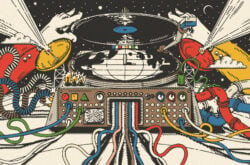Illustration: Leo Peng
When the COVID-19 pandemic started and all live events were cancelled, musicians were forced to turn to livestreaming instead.
In this sense, livestreaming has been viewed by many as a less-than-ideal, this-will-have-to-do type of alternative to live shows.
In reality, that’s not the case at all! Whether it’s performances or production sessions, livestreaming offers a unique way to connect with fans and comes with its own set of benefits that no other medium can provide. Every musician who has tried livestreaming during the pandemic has experienced these benefits, and will likely continue to stream even as the world returns to normal.
In this article, we’ll go over how livestreaming can make a difference in your music career, and six reasons why you may want to consider regularly doing it alongside live experiences in the future.
1. Livestreaming is an opportunity to engage with your audience
Livestreaming offers a chance to interact with your fans like no other. During a live event, your interactions tend to be one sided—you can speak at the crowd, but you very rarely get to have an individual say something back to you. When you livestream, on the other hand, every attendee has a chance to say something in the chat, ask a question, or make a request. You get to see these comments and respond back to them in real time. It’s a much more intimate setting, with plenty of opportunities for meaningful conversations and memorable interactions.
When you livestream, try to fit in activities other than playing music. This can be responding to comments, answering questions, telling stories, or playing games. When you do this, you take full advantage of the livestream and use it to build connections with fans. The fans who attend your streams will be much more dedicated to your music and more likely to engage with you later by streaming your songs, interacting with your social media content, and buying your merch.
2. It removes barriers to attendance
Live events can be an amazing experience for your fans, but not everyone can attend them. People must live in the city where you’re playing or have the means to travel there. Not to mention, the costs of attending a live show can add up quite quickly.
Livestreaming makes it easy for your fans to see you perform—they don’t have to leave their house, make travel arrangements, or spend a lot of money. When you remove these barriers, people from anywhere in the world can see you play.
Live music venues also have a limit on how many people can attend a single show, which doesn’t exist when you livestream. And if you’re streaming your creative process, that’s likely something that people would have never had access to to begin with.
For your music career, more people watching your streams means more potential new fans and more opportunities to promote yourself and your music.
3. It’s easier and more affordable than playing live shows
Playing live shows should absolutely be a part of your life as a musician if possible, but it can be hard to do on a regular basis. Even if you’re just playing shows in your hometown, planning each show comes with a laundry list of to-dos and expenses—you need to find a venue, rent equipment, and invest in marketing, just to name just a few. Taking your music on tour is a whole other beast—after paying for travel and accommodations, many musicians barely break even, let alone make much of a profit.
Livestreaming is a great way to supplement playing live shows and touring. Once you have the basic equipment and setup, it’s free to do, takes very little planning, and is easy to fit into your schedule. While you may only be able to put on a live show a few times a year, you can livestream as often as every week.
Not to mention, on the off chance that live events aren’t possible (say a global pandemic hits and all events are cancelled), you can still livestream regularly to keep your fans engaged, keep your live performance skills sharp, and make a bit of income.
4. It’s a great way to attract new fans
Livestreaming is an intimate and engaging experience for your audience, which is why it’s the best vehicle for converting casual listeners into loyal fans. Someone may be streaming your songs or may even follow you on social media, but that doesn’t necessarily make them a fan. Once they attend one of your livestreams, engage with you in the comments, and get to know your personality beyond who you are as a musician, they establish a much deeper relationship with you and your music.
Livestreaming can also be used to get the attention of people who’ve never heard of you before. While livestreaming on Instagram, Facebook, or TikTok is catered towards people who already follow you, there are plenty of other platforms that help you get exposed to new audiences. For example, Sessions is a platform that brings the audience to you, which means that every streamed performance is a chance to get discovered by your new biggest fan.
To maximize your exposure to new audiences, try to partner with brands, organizations, or other artists to see if you can livestream from their social media accounts. You can arrange to do an account takeover or simply be a guest on someone else’s livestream. It requires a bit of networking, but it’s one of the best ways to get exposed to potential new listeners and grow your fanbase.
5. Livestreaming can be a source of income
Depending on the platform you use, there may be an opportunity to make some money with livestreaming. You can charge for admission, admit by donation, or simply accept donations during the livestream.
If you’re considering charging for admission, remember to set the price relatively low to keep it accessible to more people. Even if you charge $5, for example, you could still end the night with substantial earnings, because unlike live venues, there’s no limit to how many people can attend. Plus, you wouldn’t have other expenses or have to give a cut to the venue.
If you admit viewers by donation, you may find that while many people will pay the bare minimum, plenty of others will be quite willing to support you. You can also accept donations during the livestream itself—most platforms allow viewers to purchase credits that they can send you in the form of gifts during the stream.
6. It can boost your social media presence
Social media accounts that regularly go live tend to have more engaged followers, which improves the performance of their other content. This ultimately results in more followers and better click-through rates (how many people leave the social media platform to check out your Spotify or merch store, for example).
It’s also possible that going live on social media could help your content get pushed to more people. Though this isn’t confirmed, many users believe that utilizing all features that a social media platform offers helps position the algorithm in your favor. The only way to find out if it’s true? Try it for yourself!
Will livestreaming replace live shows?
Absolutely not! Live shows will always remain an experience unlike any other for both musicians and their fans. However, livestreaming is just another way to engage with your audience in between live events. For some of your fans who live across the globe, this may be their only opportunity to see you play and interact with you in real-time.
Do you go live on social media or other platforms? How has it impacted your career? If not, what’s holding you back? Let us know in the comments!
Continue the conversation with veteran producer Kenny Beats’ Skills lesson on the importance of engaging with your fans:
November 10, 2021



